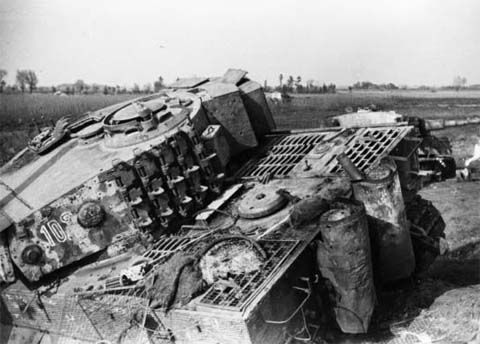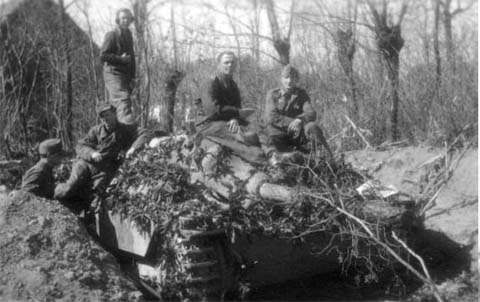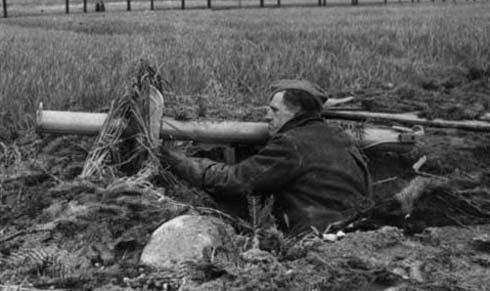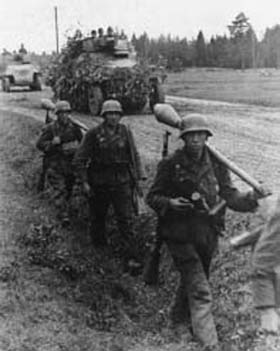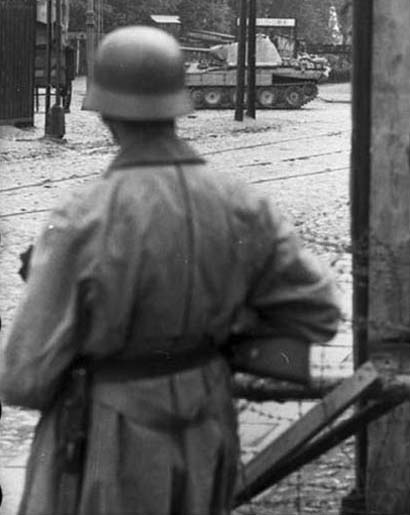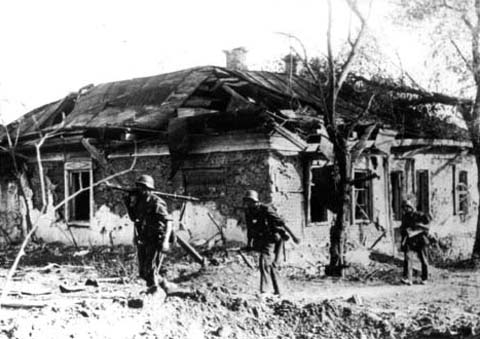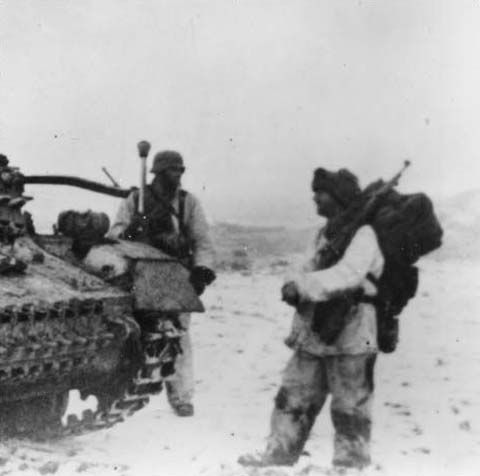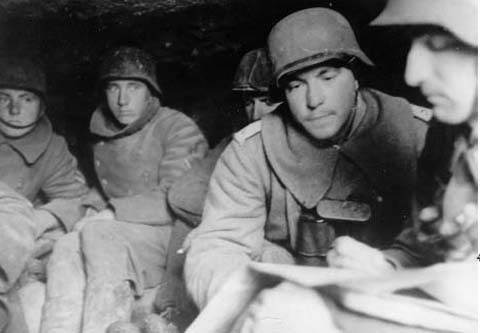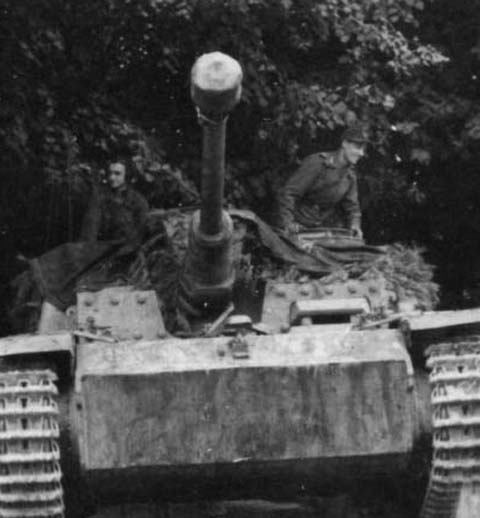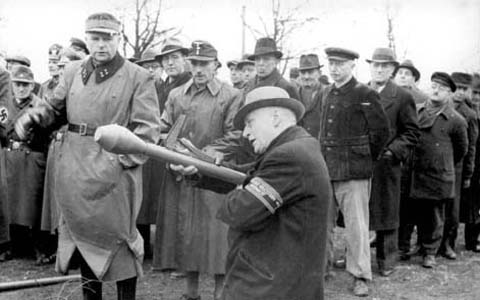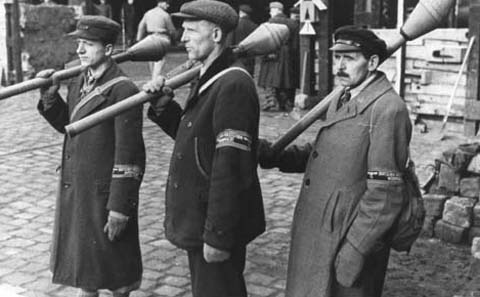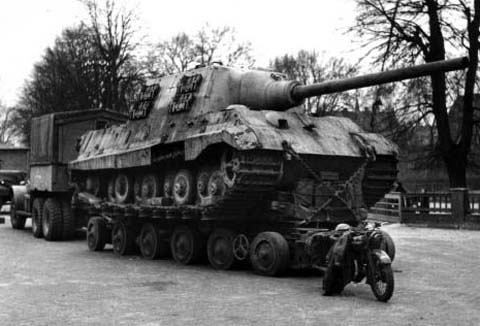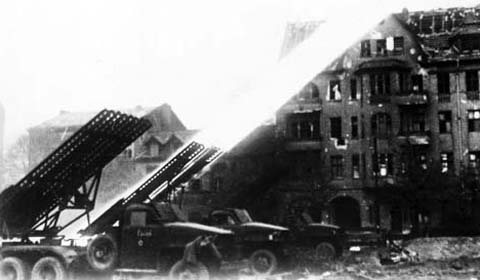The End
In the first two weeks of April German forces along the entire front from the north to the south tried to maintain their unstable position. In the north the Red Army pulled together its forces into three powerful fronts with the main effort being directed against Berlin. In the north the 2.Belorussian Front was to cross the oder north of Schwedt and strike toward Neustrelitz. Its thrust was intended to drive out the defending 3.Panzer-Armee back against the coast and cover the advance toward Berlin on the north. German forces, however, were determined to try and hold their positions for as long as possible and prevent the Russians from taking possession of German territory. But despite dogged resistance in many places the Germans no longer had the man power, equipment or transportation to defend their positions effectively. The 3.Panzer-Armee had 11 remaining divisions, whilst the 2. Belorussian Front had 8 armies totalling 33 rifle divisions, 4 tank and mechanized corps, and 3 artillery divisions plus a mixture of artillery and rocket launcher brigades and regiments. The Germans were dwarfed by enemy superiority but continued to fight from one fixed position to another.
By mid-April the 2.Belorussian Front had successfully pushed back the 3.Panzer-Armee and had taken a bridgehead ten miles long above the city of Stettin. Inside Stettin the city had been turned into a fortress and was being defended by ‘Fortress Division Stettin’. It was formed out of parts of the 3.Panzer-Armee and during its defensive battle it put up staunch resistance.
All along the receding Eastern Front Hitler gathered his commanders and told them the outcome of the war would be decided before Berlin. He outlined it was for this reason his brave legions would have to fight to save their Homeland from a Soviet invasion. Yet the average German soldier held a grim conviction that the war was lost, and yet there was still no end in sight. Being always outnumbered, perpetually short of fuel and ammunition, and having to constantly exert themselves and their machinery to the very limits of endurance had a profound effect on life at the front. The equipment situation had deteriorated too, especially in the Panzer units. The effect of depleting the experienced and elite formations like the Waffen-SS was a constant concern for the tacticians. The SS did receive a high proportion of tanks, artillery and assault guns, but this was in stark contrast to the enormous volume of armaments being produced by the Russians. The SS were thus faced with a dangerous and worsening prospect, but unlike the normal German soldier many of these elite troops retained their fanatical determination on the battlefield.
As Waffen-SS and Wehrmacht forces established defensive lines in the face of the advancing enemy, commanders looked to the aggressive and loyal striking force of the SS and counted on them to snatch victory from defeat, but even the SS were severely worn down by constant fighting. A feeling of despair and gloom prevailed across the entire German Army. But in spite this deep concern of a looming defeat the German soldier fought on. The situation for the defenders was calamitous. The Germans were well aware how important it was to prevent the Russians breaking across in to the Homeland, but there seemed no stopping the Red Army drive. Panzergrenadiers, Luftwaffe field units, Waffen-SS, Hitlerjugend and Volkssturm conscripts tried in vain to hold back the enemy onslaught, but they could not withstand the overwhelming superiority. As a result of the constant fighting the front line along the Reich was finally wrenched open and Russian troops spewed through whilst German forces withdrew westward.
There were now only two main German armies left remaining holding the front less than 100 miles east of Berlin. German panzer and infantry troops were compelled to hold the front against superior Soviet artillery and aviation. In that sector, most of the front lay on the western bank of the oder, there were two major bridgeheads still on the eastern bank: in the north, the historic town of the Stettin; to the south, the city of Frankfurt-on-oder. Both sat opposite Berlin. There were two armies holding the front to prevent the Russians from continuing their drive and capturing the German capital. on the northern wing was the 3.Panzer-Armee. Eighty miles south was the 9.Armee under the faithful command of General Theodor Busse. From one collapsed sector of the front to another, the force of some 250,000 men had slowly withdrawn to the oder. over the weeks Busse’s force had taken the full brunt of the Russian attacks, and was slowly wilting under the constant hammer blows of enemy artillery. Yet the 9.Armee was still defiantly holding in a number of places.
At Frankfurt, they had actually thrown back the enemy. Although mercilessly bombed and shelled at Seelow, the men had doggedly and persistently pinned the enemy down. But their ardent defensive tactics had cost them dearly.
on 15 April, Hitler sent an order of the Day directly to the 9.Armee’s headquarters to appeal to the soldiers to stand fast. What the Führer was actually requesting was for every man to fight to the death. However, within a few days of Hitler’s Stand Fast order the Red Army had broken through in two places and began approaching Berlin. The 9.Armee was between the two massive Russian pincers that were heading for the capital. Losses for the Germans were huge and Busse was facing a major catastrophe, and yet the General still did not consider pulling back. Retreat, except under orders, was comparable to treason. Hitler’s orders were to stand fast at all costs. With the 9.Armee denied any freedom of movement, it was certain to be destroyed. Despite constant appeals from commanders in the field ‘to act now in order to save 9.Armee from destruction’, Hitler’s stubborn hold order remained the same. From the Führer headquarters, which was now entombed 60 feet below the ravaged streets of Berlin, a message was sent to Busse sealing the fate of his army: ‘The 9.Armee must hold its position. At the same time, all forces should be made available to try and close the gap with Schorner on the southern flank so as to set up a continuous front once more’.
By 22 April, Busse’s force was almost encircled and close to annihilation. In spite of orders from Hitler headquarters that the line of defence of the order must never be abandoned, Busses with the larger half of the 9.Armee comprising of some 80,000 troops began to withdraw south-westwards towards the Spreewald in an attempt to link up with the 12.Armee.
Within days, the 9.Armee, still doggedly battling towards Wenck’s forces, were totally surrounded and being hammered night and day by Russian bombers. It did not take long before the entire northern flank of the army collapsed. The remnants of the army then shuffled along roads, tracks and fields trying to escape the slaughter. During their tortuous journey, the exhausted troops moved into a forest near the large village of Halbe. It was here that remnants of 9.Armee would endure what most of the survivors called ‘the slaughter of Halbe’.
North of the forest, as Busse’s forces tried in vain to stave off destruction inside the Halbe forest, fighting increased as Soviet forces closed on Berlin.
By 25 April Berlin was completely surrounded, and the next day some half a million Soviet troops bulldozed their way through the city. Beneath the Reich Chancellery building, the Führer was determined to save the crumbling capital and had already ordered remnants of SS-Obergruppenführer Felix Steiner’s 11.Panzer-Armee to attack immediately from their positions in the Eberswalde, then to drive south, cutting off the Russian assault on Berlin. on Hitler’s map, the plan looked brilliant. But it was impossible to gather forces to make Steiner’s SS Kampfgruppe even remotely operational. Steiner himself wrote that the forces at his disposal amounted to less than a weak Korps. He was well aware that his attack would receive little or no support as the 9.Armee was completely surrounded and the 12.Armee consisted only of a few battered divisions. As for Hitler’s reinforcements, they consisted of fewer than 5,000 Luftwaffe personnel and Hitlerjugend, all armed with hand-held weapons. The city was doomed.
For the next week the battle for Berlin raged. True to their motto, ‘My Honour is my Loyalty’, the Waffen-SS were seen fighting bitterly with members of the Hitlerjugend, Volkssturm, Luftwaffe and Wehrmacht troops. Here the soldiers were ordered to fight to the death and anyone found deserting or shirking from their duties was hunted down by Reichsführer Heinrich Himmler’s personal Escort battalion and hanged from the nearest lamp post. But even in the last days of the war both the Wehrmacht and the SS proved to be an efficient, formidable and ruthless fighting machine. Even as the last hours were fought out in the fiery cauldron of Berlin, German units, lacking all provisions including many types of weapons, effectively halted and stemmed a number of Russian assaults.
Throughout the final days of the Reich Hitler was obsessed with the belief that fanatical aggression could win victories. In a number of areas his hard line strategy actually worked, but at a huge cost in men and material. Nevertheless, the hard pressed battles fought in front of the capital essentially slowed the Russian drive and tied down an immeasurable amount of men and armour. It also prevented much of the Soviet Army from reaching the Baltic Sea, which the Germans believed would seriously curtail the U-boat training programme. The Baltic Sea had also been used throughout the war to ferry vital supplies to Army Group North, and without this important supply artery operations would have seriously been hampered. Hitler made it clear that it was imperative that the troops held the front and wage a static battle of attrition until other parts of the Russian front could be stabilized.
Geographically the battle east of Berlin was an important defensive operation for the Germans. Every soldier was made aware of the significance of holding on to as much land as possible, and it was essential that they wage a static battle of attrition until other parts of the Eastern Front could be stabilized. However, slowly and systematically the Soviet Army ground down the Germans forcing its army to withdraw deeper into the Reich and fight a determined defence wherever it could. When the last German troops were finally expunged from Russian and Baltic soil, the Red Army hailed themselves as the conquerors of fascism. Now they had to drive into Germany and take Berlin. The battle for the Reich capital was a massive undertaking for the Russians and the loss of life on both sides was immense. There are no exact casualty figures, but it is reckoned that some one million men were killed and wounded just in April alone.
Following the surrender of Berlin on 2 May 1945, the will to fight of the remaining forces still attempting to defend parts of eastern Germany, notably the scattered remnants of what was left of Army Group Vistula, quickly came to an end.
Wenck’s 12.Armee had begun to withdraw southwest of Potsdam and by the morning of 1 May it had taken some 30,000 survivors from Busse’s 9.Armee through its line. Miraculously remnants of both army groups had escaped the impending slaughter against the strongest of Russian concentrations around Berlin and had trudged westward with the sole intention of surrendering their exhausted and badly depleted forces to the US 9th Army.
Grenadier-Regiment 1944
| Regiments-Stab | |||
| Nachrichtenzug | |||
| Pionierzug | 6 x light MG34/42 | ||
| Reiter- oder Radfahrerzug | 3 x light MG34/42 | ||
| Grenadier-Bataillon (x2) | |||
| Bataillons-Stab | |||
| Schutzen-Kompanie (x3) | 16 x light MG, 2 x 8cm mortar | ||
| Maschinengewehr Kompanie | 3 x light MG, 12 xheavy MG, 4 x 8cm mortar | ||
| Leichte Infanterie Kolonne | |||
| Infanteriegeschutz-Kompanie | 5 x light MG, 6 x 7.5cm inf gun | ||
| 2 x 15cm inf gun | |||
| Panzerjäger-Kompanie | 13 x light MG, 12 x 7.5cm AT gun | ||
| Regiments Tross |
Volksgrenadier-Regiment 1944/45
| Regiments-Stab | |||
| Stabs-Kompanie | 10 x light MG34/42 | ||
| Grenadier-Bataillon (x2) | |||
| Bataillons-Stab | |||
| Versorgungszug | 2 x light MG34/42 | ||
| Grenadier-Kompanie (x3) | 9 x light MG | ||
| 6 x 7.5cm inf gun, 6 x 8cm mortar | |||
| Infanteriegeschutz-Kompanie | 5 x light MG, 4 x 7.5cm in gun, 8 x 12cm mortar | ||
| Panzerzerstörer-Kompanie | 4 x light MG | ||
| 54 x Panzerschreck | |||
| Regiment Tross |
| Regiments-Stab | |||
| Stabs-Kompanie | 10 x light MG | ||
| Greandier-Bataillon (x2) | |||
| Bataillons-Stab | |||
| Versorgungszug | 2 x light MG | ||
| Grenadier-Kompanie (x3) | 9 x light MG | ||
| Schwere Kompanie | 1 x light MG, 8 heavy MG, 4 x 7.5cm inf gun, 6 x 8cm Mortar | ||
| Schwerer Kompanie | 5 x light MG, 2 x 15cm inf gun, 8 x 12cm mortar | ||
| Panzerzerstorer-Kompanie | 4 x light MG, 54 x Panzerschreck (+ 18 in reserve) | ||
| Regiments Tross |
A knocked out Tiger tank on the road to Berlin in 1945. With too few of them delivered, Tigers, Panthers, assault guns and tank destroyer crews found that they were too thinly stretched to make any considerable dent against the growing tank might of the Red Army.
A well dug-in Jagdpanzer 38 (t) Hetzer tank destroyer has been well camouflaged by harvesting some kind of crop and applying it over much of the vehicle. It was imperative for armoured crews to reduce the risk of being attacked by heavily camouflaging their vehicles.
East Prussian Volkssturm personnel swear an oath of allegiance to Hitler in November 1944. The majority of them are armed with the Panzerfaust, whilst one soldier is armed with the Panzerschreck.(Marcin Kaludow Archive)

Two Wehrmacht soldiers move back following intensive action. The leading soldier is armed with a side arm in one have and an entrenching tool in the other. His comrade behind him who is probably a squad leader is armed with the MP38/40 submachine gun.
A 10.5cm heavy field howitzer during a fire mission. Even during the last months of the war combat experience showed that artillery support was of decisive importance in both defensive and offensive roles. It was primarily the artillery regiments that were given the task of destroying enemy positions and fortified defences and conducting counter-battery fire prior to an armoured assault.

Three photographs showing soldiers armed with the lethal Panzerschreck or tank shock. The popular name given by the troops for this weapon was the Raketenpanzerbuchse or rocket tank rifle, abbreviated to RPzB. It was an 8.8.cm reusable anti-tank rocket launcher developed during the latter half of the war. Another popular nickname was Ofenrohr or stove pipe.
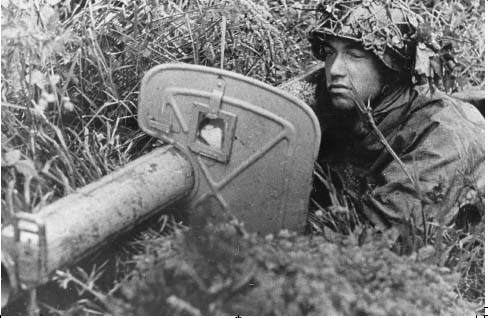
A photograph showing a pioneer attacking an enemy position. Heavily fortified positions were often heavily defended and were frequently put out of action by determined German assault pioneers. Pioneer troops were mainly employed as assault troops to supplement the infantry. Their task involved clearing minefields, breached obstacles and attacked fortifications with demolitions and flamethrowers.
Panzergrenadiers armed with Panzerfaustprojectors march along the side of the road followed by two Sd.Kfz.251/9s armed with the 7.5cm short barreled gun.
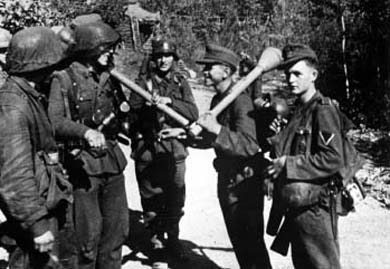
Two photographs showing Wehrmacht soldiers armed with a Panzerfaust anti-tank projector. This recoilless projector consisted of a small, disposable preloaded launch tube firing a high explosive antitank warhead, operated by a single soldier. The Panzerfaust remained in service in various versions until the end of the war. The weapon often had warnings written in large red letters on the upper rear end of the tube, warning the user of the back blast. Af ter firing, the tube was discarded, making the Panzerfaust the first disposable anti-tank weapon.
Despite overwhelming superiority of the enemy the Germans still fought fiercely and determinedly, especially during urban fighting. Here in this photograph a squad leader armed with a MP38/40 submachine gun has captured a group of Russian soldiers during heavy intensive fighting inside a town.
A soldier stands on the corner of a road and watches a Panther tank slowly taking up a position inside a town. Following the battle of Stalingrad in late 1942 the Germans had become masters of urban fighting and could hold up an attacking force for many hours, days, or even weeks.
An MG34 machine gun crew passes a destroyed building during bitter fighting. An MG34 machine gunner can be seen with his weapon slung over his shoulder. The vast majority of distances travelled by the infantry were done on foot. This was often exhausting for the soldiers, especially when they were compelled to fight before or after reaching their destination.
Here a well camouflaged Ferdinand Elefant has run out of fuel. This tank destroyer was capable of defeating all types of Soviet tanks, but the vehicle lacked cross-country mobility and were prone to breakdowns.
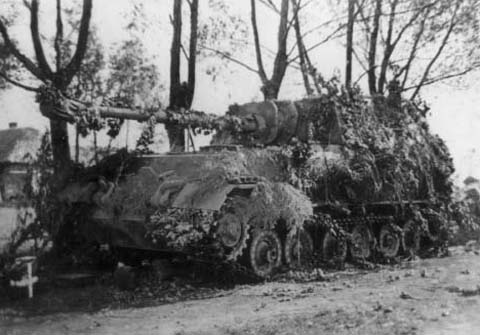
A destroyed or abandoned Hetzer 7.5cm tank destroyer somewhere in eastern Europe.
A Jagdpanzer IV armed with a powerful 7.5cm gun barrel. Marching alongside on foot are grenadiers armed with the Panzerfaust. These Panzer IV/70 reached the Panzer units in small number until the end of the war.
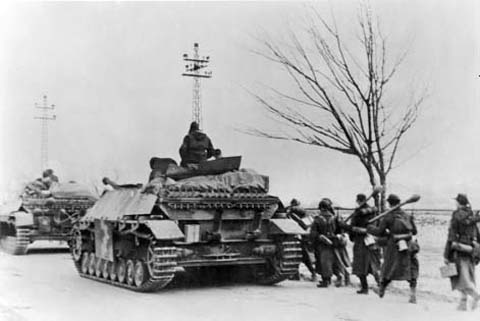
Troops in a typical trench system during defensive actions along the front lines. The earth was often thrown by shovel to the front of the trench in order to create a high protective wall of defence. Planks to support the sides were often erected in unstable soil and to prevent it from being collapsed by nearby artillery strikes. As the war drew to the last remaining weeks there was almost no respite on the front line and the dwindling numbers of soldiers to man the already over extended front was causing unprecedented problems.
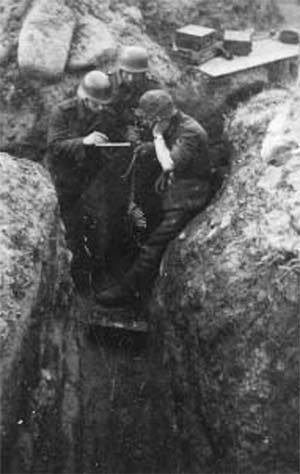
A British soldier surveyors a knocked out Tiger.I’s which has a full application of zimmerit anti-mine paste. During the war, these vehicles constantly demonstrated both the effectiveness of their 8.8cm guns and their invulnerability to Soviet anti-tank projectiles smaller than 8.5cm. However, there were too few to make any significant advancement against their enemy.
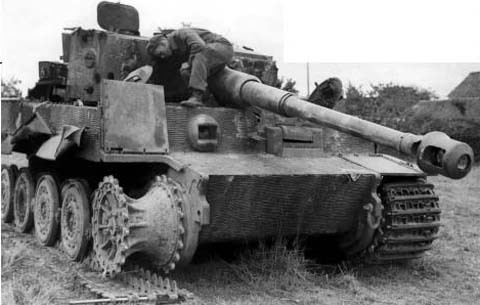
Grenadiers, one armed with a Panzerfaust and the other a standard German infantry rifle, stand beside a tank during the last months of the war on the Eastern Front.
Soviet artillery in action against a German position. The 122mm howitzer M1938 saw extensive action on the Eastern Front mainly as a divisional artillery piece of the Red Army. Captured guns were also employed later by the Wehrmacht and the Finnish Army.
A foreign General decorates one of his men for bravery in the field during the battle for the Baltic States. It was here in the Baltic States of Estonia, Latvia and Lithuania where German forces and their remaining allied troops tried desperately to prevent the Red Army from spilling across into northern Germany and driving on to Berlin.
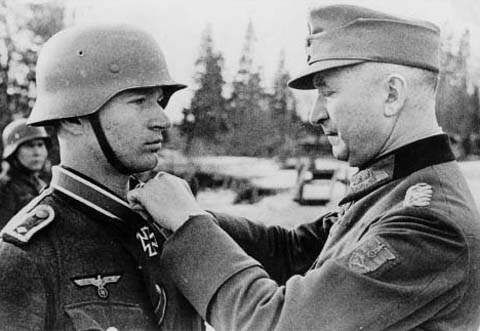
A photograph showing a soldier getting decorated for his courageous attempts to stem the mighty Soviet forces from breaking through the German lines during the last months of the war.
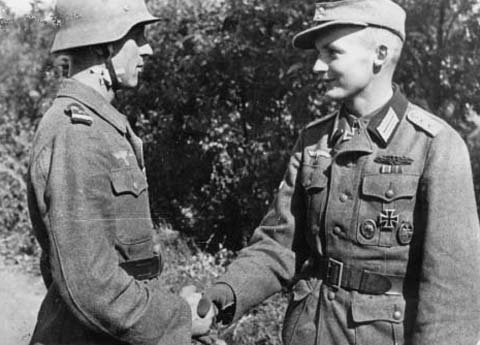
Troops take refuge in one of many bunker systems that littered the front lines. Often these bunkers were constructed quickly out of wood and afforded little in the way of protection against artillery. However, it did offer soldiers protection against machine gun and small arms fire.
One of the key areas of defence was along main roads. Here an 8.8cm FlaK crew have positioned there gun near to a road to defend the position against advancing ground forces. Note how the crew have purposely avoided positioning the gun on the road.
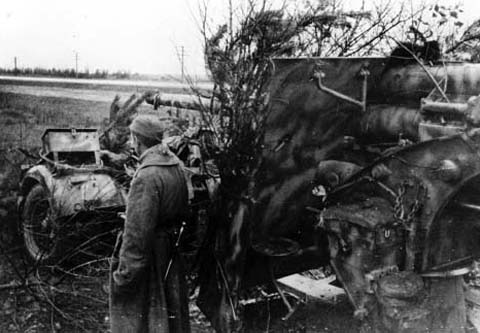
Whilst the StuH with 10.5cm howitzer proved its worth on the battlefield in spite its dwindling numbers, other forces supporting the vehicle were poorly supplied or lacked the equipment to deal with the enemy. As a consequence these assault guns frequently assisted the dwindling front lines, but it was invariably swamped by overwhelming Russian forces. Losses were massive.
Scraping the barrel – two photograph showing newly conscripted Volkssturm during the last weeks of the war. Members of the Volkssturm only received very basic training and there was also a serious lack of trainers, which meant many of them went to the front barely able to use their weapons properly. The majority of them were armed with either the Karabiner 98K bolt action rifle or the Panzerfaust, as in these photographs. It was often down to these men to help defend towns and villages from the onrushing enemy forces. Quite regularly Volkssturm conscripts threw down their arms as the attacking forces approached and went into hiding. However, there were some that fought to the death, but still rarely held back the Russian forces for any appreciable time.
With Soviet aircraft now ruling the skies in the East many German divisions had increased their antiaircraft battalions, with each of them containing two or even three heavy batteries. In this photograph it shows an 8.8cm FlaK gun complete with Schützchild (protective shield). In some sectors of the front, some units barely had enough Panzers to oppose the Russian armour and called upon FlaK battalions to halt the Red Army’s attacks. During this later period many FlaK guns came to be assigned dual purposes, which involved adding an anti-tank role to their operational duties. Note the kill rings on the barrel of this 8.8cm FlaK gun.
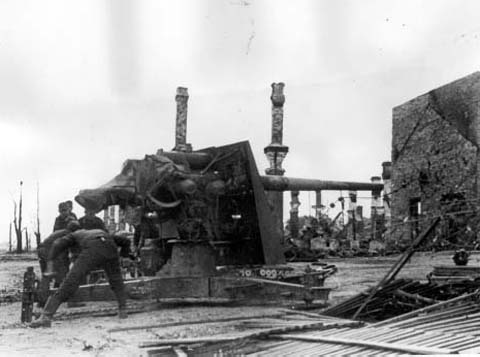
A captured Jagtiger on a Gotha 80 tonne trailer being prepared to be taken to England for inspection. Although the fire power of the Jagdtiger was lethal, its mobility was restricted mainly due to fuel shortages and mechanical breakdowns. They were also very slow moving and a relatively easy target for fighter-bombers. This is a non-standard version with experimental Porsche suspension.
Two soldiers fighting inside a rubble strewn town during defensive actions in 1945. Both troops appear to be conscripts. Whilst these conscripts had a considerable lack of experience on the battlefield Red Army troops still encountered considerable resistance in a number of areas. In front of Berlin for instance there were a number of Hitlerjugend, Volkssturm, and other militia forces that attacked wherever and whenever they could, despite the tactical futility of their actions.
Troops move along a railway line passing what appears to be a well camouflaged gun train. In spite the staunch resistance put-up by the Germans nothing could prevent the enemy onslaught.
When the Russians finally bulldozed their way into Berlin in April 1945, they flamed, bombarded and machine gunned the defenders, crushing them into the piles of rubble that littered the city. Where the Germans put up a determined resistance, the whole area was saturated by Katyusha rocket fire, as in this photograph. Note the metal blast covers protecting the vehicles windshields.
